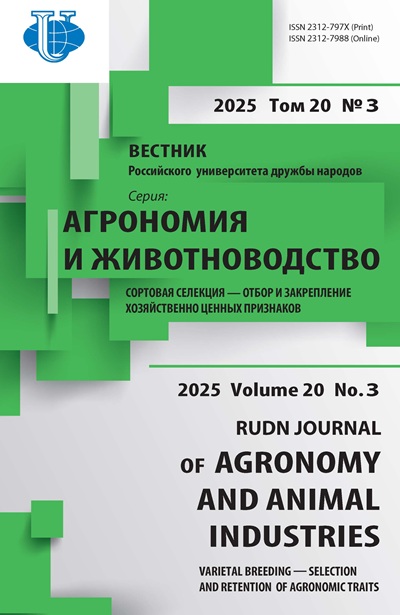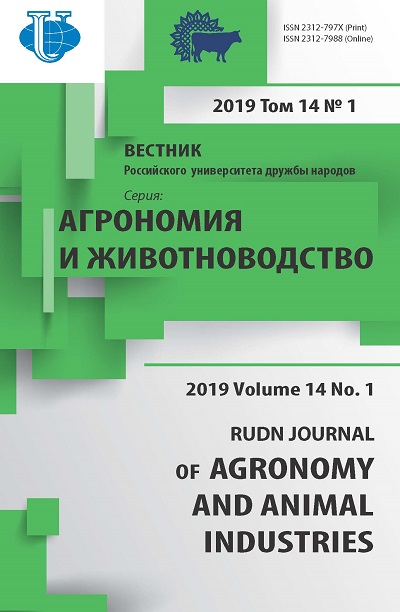ВЛИЯНИЕ БЕТА-АМИНОМАСЛЯНОЙ КИСЛОТЫ НА АКТИВНОСТЬ ПЕРОКСИДАЗЫ И ПОЛИФЕНОЛ-ОКСИДАЗЫ У РАСТЕНИЙ ОГУРЦА, ПОРАЖЕННЫХ НЕМАТОДОЙ MELOIDOGYNE JAVANICA
- Авторы: Mahmoudi N.1
-
Учреждения:
- Российский университет дружбы народов
- Выпуск: Том 14, № 1 (2019)
- Страницы: 7-17
- Раздел: Растениеводство
- URL: https://agrojournal.rudn.ru/agronomy/article/view/19470
- DOI: https://doi.org/10.22363/2312-797X-2019-14-1-7-17
- ID: 19470
Цитировать
Полный текст
Аннотация
Бета-аминомасляная кислота вводится в качестве индуктора устойчивости растений к патогенам растений. В данной работе была исследована индукция некоторых защитных соединений, в том числе ферментов пероксидазы и полифенолоксидазы этим соединением, против нематоды Meloidogyne javanica , продуцирующей узел корневища, в огурце. Результаты показали, что инокуляция корней зараженного огурца нематодой из корневых узлов с химическим составом БAМК с первого дня после инокуляции нематодой увеличивала активность фермента пероксидазы и достигала своего максимума на четвертый день этой активности. Индукция активности фермента полифенолоксидазы показала постепенное увеличение со значительной разницей по сравнению с контрольными и здоровыми растениями и достигла максимума на четвертый день. Электрофорез пероксидазных изозимов показал, что изоферментные пероксидазные формы в корнях огурца, индуцированные БAМК, гораздо более эффективны, чем индуцируемые патогеном изозимы. У растений, обработанных нематодой плюс БAМК, два изофермента имеют Rf = 00,31 и Rf = 34/0, которые являются более сильными, чем контроль (инокулированные нематодой).
Об авторах
Niloufar Mahmoudi
Российский университет дружбы народов
Автор, ответственный за переписку.
Email: niloofarmahmoodi@ymail.com
-
117198, Москва, ул. Миклухо-Маклая, д. 6Список литературы
- Triki E., Trabelsi I., Amri M., Nefzi F., Kharrat M., Abbes Z. Effect of benzothiadiazole and salicylic acid resistance inducers on Orobanche foetida infestation in Vicia faba. Tunisian Journal of Plant Protection. 2018; 13(1):113-125.
- Zhong Y., Wang B., Yan J., Cheng L., Yao L., Xiao L., Wu T. DL-β-aminobutyric acid-induced resistance in soybean against Aphis glycines Matsumura (Hemiptera: Aphididae). PloS one. 2014; 9(1):e85142. Available from: doi: 10.1371/journal.pone.0085142.
- Gao J., Bi W., Li H., Wu J., Yu X., Liu D., Wang X. WRKY transcription factors associated with NPR1-mediated acquired resistance in barley are potential resources to improve wheat resistance to Puccinia triticina. Frontiers in plant science. 2018; (9):1486. Available from: doi: 10.3389/fpls.2018.01486.
- Abad P., Favery B., Rosso M.N., Castagnone-Sereno P. Root-knot nematode parasitism and host response: molecular basis of a sophisticated interaction. Molecular plant pathology. 2003; 4(4):217-224. Available from: doi: 10.1046/j.1364-3703.2003.00170.x.
- Nguyen C.N., Perfus-Barbeoch L., Quentin M., Zhao J., Magliano M., Marteu N., Da Rocha M., Nottet N., Abad P., Favery B. A root-knot nematode small glycine and cysteine-rich secreted effector, MiSGCR1, is involved in plant parasitism. New Phytologist. 2018; 217(2):687-699. Available from: doi: 10.1111/nph.14837.
- Görlach J., Volrath S., Knauf-Beiter G., Hengy G., Beckhove U., Kogel K.H., Oostendorp M., Staub T., Ward E., Kessmann H., Ryals J. Benzothiadiazole, a novel class of inducers of systemic acquired resistance, activates gene expression and disease resistance in wheat. The Plant Cell. 1996; 8(4):629-643. Available from: doi: 10.1105/tpc.8.4.629.
- Wagner A., Norris S., Chatterjee P., Morris P.F., Wildschutte H. Aquatic Pseudomonads inhibit oomycete plant pathogens of glycine max. Frontiers in microbiology. 2018; (9):1007. Available from: doi: 10.3389/fmicb.2018.01007.
- Singh S., Singh A., Kumar S., Mittal P., Singh I.K. Protease inhibitors: recent advancement in its usage as a potential biocontrol agent for insect pest management. Insect science. 2018. Available from: doi: 10.1111/1744-7917.12641.
- Starý T., Satková P., Piterková J., Mieslerová B., Luhová L., Mikulík J., Kašparovský T., Petřivalský M., Lochman J. The elicitin β-cryptogein’s activity in tomato is mediated by jasmonic acid and ethylene signalling pathways independently of elicitin-sterol interactions. Planta. 2018. 1-11. Available from: doi: 10.1007/s00425-018-3036-1.
- Alshammari G.M., Balakrishnan A., Chinnasamy T. Protective role of germinated mung bean against progression of non-alcoholic steatohepatitis in rats: A dietary therapy to improve fatty liver health. Journal of Food Biochemistry. 2018; 42(5):e12542. Available from: doi: 10.1111/jfbc.12542.
- Oort A.J.P., Van Andel O.M. Aspects in chemotherapy. Mededel. Opz. Gent. 1960; 25:961-992.
- Prasad S., Webster J.M. The effect of amino acid antimetabolites on four nematode species and their host plants. Nematologica. 1967; 13(2):318-320.
- Cohen Y.R. β-aminobutyric acid-induced resistance against plant pathogens. Plant disease. 2002; 86(5):448-457. Available from: doi: 10.1094/PDIS.2002.86.5.448.
- Ben Rejeb I. BABA in priming tomato for enhanced tolerance to drought, salinity and fungal stress and combinations thereof. [Dissertation] Neuchâtel; 2018.
- Singh S.K., Sung T.Y., Chung T.Y., Lin S.Y., Lin S.C., Liao J.C., Hsieh W.Y., Hsieh M.-H. ACR11 modulates levels of reactive oxygen species and salicylic acid-associated defense response in Arabidopsis. Scientific reports. 2018; 8(1):11851. Available from: doi: 10.1038/s41598-018-30304-0.
- Wilkinson S., Pastor V., Paplauskas S., Pétriacq P., Luna E. Long-lasting β-aminobutyric acid-induced resistance protects tomato fruit against Botrytis cinerea. Plant Pathology. 2018; 67(1):30-41. Available from: doi: 10.1111/ppa.1272517.
- Powell G., Hodge S. Effects of β-aminobutyric acid on aphid stylet activities. IOBC-WPRS Bulletin. 2018; 135:124-126.
- Li K., Wu G., Li M., Ma M., Du J., Sun M., Sun X., Qing L. Transcriptome analysis of Nicotiana benthamiana infected by Tobacco curly shoot virus. Virology journal. 2018; 15(1):138. Available from: doi: 10.1186/s12985-018-1044-1.
- Devran Z., Baysal Ö. Induction of resistance to Meloidogyne incognita by DL-beta amino butyric acid under salt stress condition. Australasian Plant Disease Notes. 2018; 13(1):20. Available from: doi: 10.1007/s13314-018-0304-7.
- Oka Y., Cohen Y., Spiegel Y. Local and systemic induced resistance to the root-knot nematode in tomato by DL-β-amino-n-butyric acid. Phytopathology. 1999; 89(12):1138-1143. Available from: doi: 10.1094/PHYTO.1999.89.12.1138.
- Hussey R.S. A comparison of methods of collecting inocula of Meloidogyne spp., including a new technique. Plant Dis. Rep. 1973; 57:1025-1028.
- Reuveni R., Bothma G.S. The relationship between peroxidase activity and resistance to Sphaerotheca fuliginea in melons. Journal of Phytopathology. 1985; 114(3):260-267. Available from: doi: 10.1111/j.1439-0434.1985.tb00851.x.
- Bradford M.M. A rapid and sensitive method for the quantitation of microgram quantities of protein utilizing the principle of protein-dye binding. Analytical Biochemistry. 1976; 72 (1-2):248-254.
- Diniz I., Azinheira H., Figueiredo A., Gichuru E., Oliveira H., Guerra-Guimarães L., Silva M.C. Fungal penetration associated with recognition, signaling and defence-related genes and peroxidase activity during the resistance response of coffee to Colletotrichum kahawae. Physiological and Molecular Plant Pathology. 2018. Available from: doi: 10.1016/j.pmpp.2017.12.005.
- Porat R., Vinokur V., Weiss B., Cohen L., Daus A., Goldschmidt E.E., Droby S. Induction of resistance to Penicillium digitatum in grapefruit by β-aminobutyric acid. European Journal of Plant Pathology. 2003; 109(9):901-907. Available from: doi: 10.1023/B:EJPP.0000003624.28975.45.
- Sabbagh E., Sabbagh S.K., Panjehkeh N., Bolok-Yazdi H.R. Jasmonic acid induced systemic resistance in infected cucumber by Pythium aphanidermatum. Tarim Bilimleri Dergisi-Journal of Agricultural Sciences. 2018; 24(1):143-152.
- Hossain M.A., Li Z.G., Hoque T.S., Burritt D.J., Fujita M., Munné-Bosch S. Heat or cold priming-induced cross-tolerance to abiotic stresses in plants: key regulators and possible mechanisms. Protoplasma. 2018; 255(1):399-412. Available from: doi: 10.1007/s00709-017-1150-8.
- Dorjey S., Dolkar D., Sharma R. Plant growth promoting rhizobacteria Pseudomonas: a review. Int J Curr Microbiol App Sci. 2017; 6(7):1335-1344. Available from: doi: 10.20546/ijcmas. 2017.607.160.
- Vasanthi V., Samiyappan R., Vetrivel T. Development of a new chitin based bio-formulation of Pseudomonas fluorescens and a natural insecticide (Vitex trifolia) against Indian Tomato Leaf Curl Virus (iTLCV) and its whitefly vector. The Pharma Innovation Journal. 2017; 6(11): 574-578.
- Castagnone-Sereno P. Meloidogyne enterolobii (= M. mayaguensis): profile of an emerging, highly pathogenic, root-knot nematode species. Nematology. 2012; 14(2):133-138. Available from: doi: 10.1163/156854111X601650.
- Nuñez A.M., Rodríguez G.A., Monteiro F.P., Faria A.F., Silva J.C., Monteiro A.C., Carvalho C.V., Gomes L.A., Souza R.M., de Souza J.T., Medeiros F.H. Bio-based products control black rot (Xanthomonas campestris pv. campestris) and increase the nutraceutical and antioxidant components in kale. Scientific Reports. 2018; 8(1):10199. Available from: doi: 10.1038/s41598-018-28086-6.
- Zheng Y., Wang X., Liu S., Zhang K., Cai Z., Chen X., Zhang Y., Liu J., Wang A. The endochitinase of Clonostachys rosea expression in Bacillus amyloliquefaciens enhances the Botrytis cinerea resistance of tomato. International Journal of Molecular Sciences. 2018; 19(8):2221. Available from: doi: 10.3390/ijms19082221.
- Shikano I., Pan Q., Hoover K., Felton G.W. Herbivore-induced defenses in tomato plants enhance the lethality of the entomopathogenic bacterium, Bacillus thuringiensis var. kurstaki. Journal of Chemical Ecology. 2018; 44(10):947-956. Available from: doi: 10.1007/s10886-018-0987-4.
- Babu A.N., Jogaiah S., Ito S.I., Nagaraj A.K., Tran L.S.P. Improvement of growth, fruit weight and early blight disease protection of tomato plants by rhizosphere bacteria is correlated with their beneficial traits and induced biosynthesis of antioxidant peroxidase and polyphenol oxidase. Plant Science. 2015; 231:62-73. Available from: doi: 10.1016/j.plantsci.2014.11.006.
Дополнительные файлы















